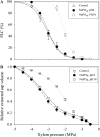Calcium is a major determinant of xylem vulnerability to cavitation
- PMID: 20547703
- PMCID: PMC2923875
- DOI: 10.1104/pp.110.155200
Calcium is a major determinant of xylem vulnerability to cavitation
Abstract
Xylem vulnerability to cavitation is a key parameter in the drought tolerance of trees, but little is known about the control mechanisms involved. Cavitation is thought to occur when an air bubble penetrates through a pit wall, and would hence be influenced by the wall's porosity. We first tested the role of wall-bound calcium in vulnerability to cavitation in Fagus sylvatica. Stems perfused with solutions of oxalic acid, EGTA, or sodium phosphate (NaPO(4)) were found to be more vulnerable to cavitation. The NaPO(4)-induced increase in vulnerability to cavitation was linked to calcium removal from the wall. In contrast, xylem hydraulic conductance was unaffected by the chemical treatments, demonstrating that the mechanisms controlling vulnerability to cavitation and hydraulic resistance are uncoupled. The NaPO(4) solution was then perfused into stems from 13 tree species possessing highly contrasted vulnerability to cavitation. Calcium was found to be a major determinant of between-species differences in vulnerability to cavitation. This was evidenced in angiosperms as well as conifer species, thus supporting the hypothesis of a common mechanism in drought-induced cavitation.
Figures




Similar articles
-
Xylem embolism threshold for catastrophic hydraulic failure in angiosperm trees.Tree Physiol. 2013 Jul;33(7):672-83. doi: 10.1093/treephys/tpt030. Epub 2013 May 8. Tree Physiol. 2013. PMID: 23658197
-
Water stress-induced xylem hydraulic failure is a causal factor of tree mortality in beech and poplar.Ann Bot. 2013 Nov;112(7):1431-7. doi: 10.1093/aob/mct204. Epub 2013 Sep 29. Ann Bot. 2013. PMID: 24081280 Free PMC article.
-
Acclimation of branch and leaf hydraulics in adult Fagus sylvatica and Picea abies in a forest through-fall exclusion experiment.Tree Physiol. 2018 Feb 1;38(2):198-211. doi: 10.1093/treephys/tpx140. Tree Physiol. 2018. PMID: 29177459
-
Vulnerability to drought-induced cavitation in poplars: synthesis and future opportunities.Plant Cell Environ. 2015 Jul;38(7):1233-51. doi: 10.1111/pce.12491. Epub 2015 Jan 23. Plant Cell Environ. 2015. PMID: 25444560 Review.
-
Hydraulic safety margins and embolism reversal in stems and leaves: why are conifers and angiosperms so different?Plant Sci. 2012 Oct;195:48-53. doi: 10.1016/j.plantsci.2012.06.010. Epub 2012 Jun 26. Plant Sci. 2012. PMID: 22920998 Review.
Cited by
-
Arabidopsis thaliana as a model species for xylem hydraulics: does size matter?J Exp Bot. 2013 May;64(8):2295-305. doi: 10.1093/jxb/ert087. Epub 2013 Apr 1. J Exp Bot. 2013. PMID: 23547109 Free PMC article.
-
Nobody's perfect: can irregularities in pit structure influence vulnerability to cavitation?Front Plant Sci. 2013 Nov 12;4:453. doi: 10.3389/fpls.2013.00453. eCollection 2013. Front Plant Sci. 2013. PMID: 24273549 Free PMC article.
-
Cavitation and its discontents: opportunities for resolving current controversies.Plant Physiol. 2014 Apr;164(4):1649-60. doi: 10.1104/pp.113.233817. Epub 2014 Feb 5. Plant Physiol. 2014. PMID: 24501002 Free PMC article. Review.
-
The hydraulic efficiency-safety trade-off differs between lianas and trees.Ecology. 2019 May;100(5):e02666. doi: 10.1002/ecy.2666. Epub 2019 Apr 8. Ecology. 2019. PMID: 30801680 Free PMC article.
-
Plant water uptake in drying soils.Plant Physiol. 2014 Apr;164(4):1619-27. doi: 10.1104/pp.113.233486. Epub 2014 Feb 10. Plant Physiol. 2014. PMID: 24515834 Free PMC article. Review.
References
-
- Barigah TS, Ibrahim T, Bogard A, Faivre-Vuillin B, Lagneau LA, Montpied P, Dreyer E. (2006) Irradiance-induced plasticity in the hydraulic properties of saplings of different temperate broad-leaved forest tree species. Tree Physiol 26: 1505–1516 - PubMed
-
- Chaffey NJ, Barnett JR, Barlow PW. (1997) Visualization of the cytoskeleton within the secondary vascular system of hardwood species. J Microsc 187: 77–84 - PubMed
-
- Choat B, Cobb AR, Jansen S. (2008) Structure and function of bordered pits: new discoveries and impacts on whole-plant hydraulic function. New Phytol 177: 608–625 - PubMed
MeSH terms
Substances
LinkOut - more resources
Full Text Sources

